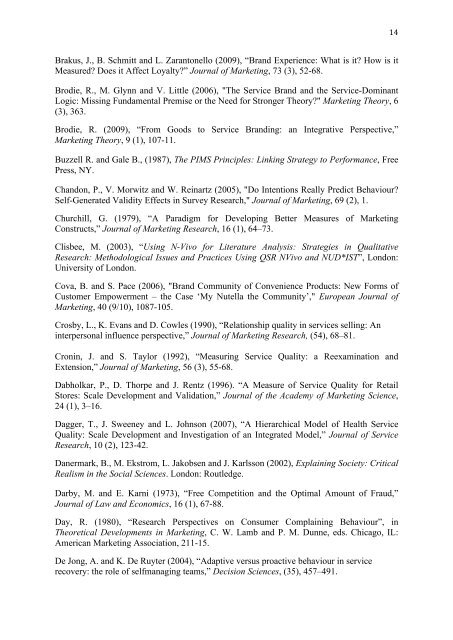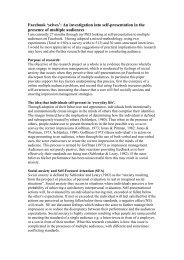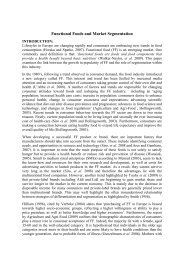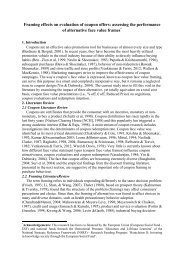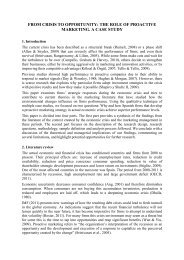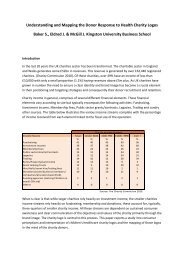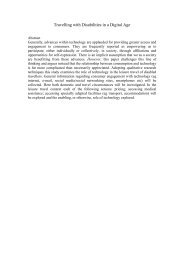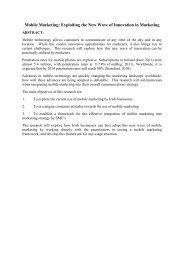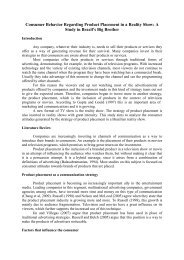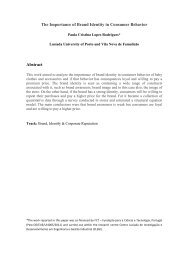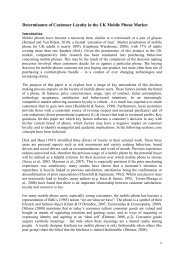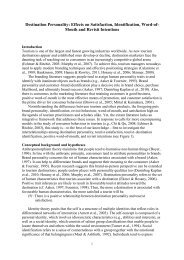EXQ: A Multiple-Item Scale for Assessing Customer Experience In ...
EXQ: A Multiple-Item Scale for Assessing Customer Experience In ...
EXQ: A Multiple-Item Scale for Assessing Customer Experience In ...
Create successful ePaper yourself
Turn your PDF publications into a flip-book with our unique Google optimized e-Paper software.
<br />
Brakus, J., B. Schmitt and L. Zarantonello (2009), “Brand <strong>Experience</strong>: What is it? How is it<br />
Measured? Does it Affect Loyalty?” Journal of Marketing, 73 (3), 52-68.<br />
Brodie, R., M. Glynn and V. Little (2006), "The Service Brand and the Service-Dominant<br />
Logic: Missing Fundamental Premise or the Need <strong>for</strong> Stronger Theory?" Marketing Theory, 6<br />
(3), 363.<br />
Brodie, R. (2009), “From Goods to Service Branding: an <strong>In</strong>tegrative Perspective,”<br />
Marketing Theory, 9 (1), 107-11.<br />
Buzzell R. and Gale B., (1987), The PIMS Principles: Linking Strategy to Per<strong>for</strong>mance, Free<br />
Press, NY.<br />
Chandon, P., V. Morwitz and W. Reinartz (2005), "Do <strong>In</strong>tentions Really Predict Behaviour?<br />
Self-Generated Validity Effects in Survey Research," Journal of Marketing, 69 (2), 1.<br />
Churchill, G. (1979), “A Paradigm <strong>for</strong> Developing Better Measures of Marketing<br />
Constructs,” Journal of Marketing Research, 16 (1), 64–73.<br />
Clisbee, M. (2003), “Using N-Vivo <strong>for</strong> Literature Analysis: Strategies in Qualitative<br />
Research: Methodological Issues and Practices Using QSR NVivo and NUD*IST”, London:<br />
University of London.<br />
Cova, B. and S. Pace (2006), "Brand Community of Convenience Products: New Forms of<br />
<strong>Customer</strong> Empowerment – the Case ‘My Nutella the Community’," European Journal of<br />
Marketing, 40 (9/10), 1087-105.<br />
Crosby, L., K. Evans and D. Cowles (1990), “Relationship quality in services selling: An<br />
interpersonal influence perspective,” Journal of Marketing Research, (54), 68–81.<br />
Cronin, J. and S. Taylor (1992), “Measuring Service Quality: a Reexamination and<br />
Extension,” Journal of Marketing, 56 (3), 55-68.<br />
Dabholkar, P., D. Thorpe and J. Rentz (1996). “A Measure of Service Quality <strong>for</strong> Retail<br />
Stores: <strong>Scale</strong> Development and Validation,” Journal of the Academy of Marketing Science,<br />
24 (1), 3–16.<br />
Dagger, T., J. Sweeney and L. Johnson (2007), “A Hierarchical Model of Health Service<br />
Quality: <strong>Scale</strong> Development and <strong>In</strong>vestigation of an <strong>In</strong>tegrated Model,” Journal of Service<br />
Research, 10 (2), 123-42.<br />
Danermark, B., M. Ekstrom, L. Jakobsen and J. Karlsson (2002), Explaining Society: Critical<br />
Realism in the Social Sciences. London: Routledge.<br />
Darby, M. and E. Karni (1973), “Free Competition and the Optimal Amount of Fraud,”<br />
Journal of Law and Economics, 16 (1), 67-88.<br />
Day, R. (1980), “Research Perspectives on Consumer Complaining Behaviour”, in<br />
Theoretical Developments in Marketing, C. W. Lamb and P. M. Dunne, eds. Chicago, IL:<br />
American Marketing Association, 211-15.<br />
De Jong, A. and K. De Ruyter (2004), “Adaptive versus proactive behaviour in service<br />
recovery: the role of selfmanaging teams,” Decision Sciences, (35), 457–491.<br />
14


